Soil and Climate Characterization to Define Environments for Summer Crops in Senegal
Abstract
:1. Introduction
2. Materials and Methods
2.1. Study Area
2.2. Data Sources and Processing
2.2.1. Soil Data
2.2.2. Climate Data
2.3. Protocol Sequence
2.3.1. Principal Component Analysis
2.3.2. Cluster Analysis
3. Results
3.1. Environmental Description
3.2. Soil Classification
3.3. Climate Classification
3.4. Relationship between Monthly Climate Patterns among Soil Zones
4. Discussion
5. Conclusions
Supplementary Materials
Author Contributions
Funding
Institutional Review Board Statement
Informed Consent Statement
Data Availability Statement
Acknowledgments
Conflicts of Interest
References
- United Nations World Population Dashboard Senegal. Available online: https://www.unfpa.org/data/world-population/SN (accessed on 14 September 2021).
- Molina-Flores, B.; Manzano-Baena, P.; Coulibaly, M.D.; Bedane, B. The Role of Livestock in Food Security, Poverty Reduction and Wealth Creation in West Africa; FAO: Rome, Italy, 2020; ISBN 9789251323397. [Google Scholar]
- Gregory, P.J.; Ingram, J.S.I.; Brklacich, M. Climate change and food security. Philos. Trans. R. Soc. B Biol. Sci. 2005, 360, 2139–2148. [Google Scholar] [CrossRef] [PubMed]
- Lobell, D.B.; Burke, M.B.; Tebaldi, C.; Mastrandrea, M.D.; Falcon, W.P.; Naylor, R.L. Prioritizing climate change adaptation needs for food security in 2030. Science 2008, 319, 607–610. [Google Scholar] [CrossRef] [PubMed]
- Burke, M.B.; Miguel, E.; Satyanath, S.; Dykema, J.A.; Lobell, D.B. Warming increases the risk of civil war in Africa. Proc. Natl. Acad. Sci. USA 2009, 106, 20670–20674. [Google Scholar] [CrossRef] [Green Version]
- FAO. Global Livestock Production Systems; FAO: Rome, Italy, 2011; ISBN 978-92-5-107033-8. [Google Scholar]
- Rasmussen, K.; D’haen, S.; Fensholt, R.; Fog, B.; Horion, S.; Nielsen, J.O.; Rasmussen, L.V.; Reenberg, A. Environmental change in the Sahel: Reconciling contrasting evidence and interpretations. Reg. Environ. Chang. 2016, 16, 673–680. [Google Scholar] [CrossRef]
- Wheeler, T.; von Braun, J. Climate change impacts on global food security. Science 2013, 341, 1689–1699. [Google Scholar] [CrossRef]
- Pozza, L.E.; Field, D.J. The science of soil security and food security. Soil Secur. 2020, 1, 100002. [Google Scholar] [CrossRef]
- Teluguntla, P.; Thenkabail, P.S.; Xiong, J.; Congalton, R.; Tilton, J.; Sankey, T.T.; Massey, R. Global cropland area database (GCAD) derived from remote sensing in support of food security in the twenty-first century: Current achievements and future possibilities. Remote Sens. Handb. 2015, II, 1–45. [Google Scholar]
- Koch, A.; Mcbratney, A.; Adams, M.; Field, D.; Hill, R.; Crawford, J.; Minasny, B.; Lal, R.; Abbott, L.; O’Donnell, A.; et al. Soil security: Solving the global soil crisis. Glob. Policy 2013, 4, 434–441. [Google Scholar] [CrossRef] [Green Version]
- Lal, R. Soil degradation by erosion. Land Degrad. Dev. 2001, 12, 519–539. [Google Scholar] [CrossRef]
- Wortmann, C.S.; Stewart, Z. Nutrient management for sustainable food crop intensification in African tropical savannas. Agron. J. 2021. [Google Scholar] [CrossRef]
- Stewart, Z.P.; Pierzynski, G.M.; Middendorf, B.J.; Vara Prasad, P.V. Approaches to improve soil fertility in Sub-Saharan Africa. J. Exp. Bot. 2020, 71, 632–641. [Google Scholar] [CrossRef] [Green Version]
- Vagen, T.-G.; Winowiecki, L.A.; Desta, L.; Tondoh, E.J.; Weullow, E.; Shepherd, K.; Sila, A. Mid-Infrared Spectra (MIRS) from ICRAF Soil and Plant Spectroscopy Laboratory: Africa Soil Information Service (AfSIS) Phase I 2009–2013; The World Agroforestry Centre: Nairobi, Kenya, 2020. [Google Scholar]
- Leenaars, J.G.B.; Kempen, B.; van Oostrum, A.J.M.; Batjes, N.H. Africa soil profiles database: A compilation of georeferenced and standardised legacy soil profile data for Sub-Saharan Africa. In GlobalSoilMap: Basis of the Global Spatial Soil Information System; CRC Press: Boca Raton, FL, USA, 2014; pp. 51–57. [Google Scholar]
- Hengl, T.; Heuvelink, G.B.M.; Kempen, B.; Leenaars, J.G.B.; Walsh, M.G.; Shepherd, K.D.; Sila, A.; MacMillan, R.A.; De Jesus, J.M.; Tamene, L.; et al. Mapping soil properties of Africa at 250 m resolution: Random forests significantly improve current predictions. PLoS ONE 2015, 10, e0125814. [Google Scholar] [CrossRef]
- Hertel, T.W. Food security under climate change. Nat. Clim. Chang. 2016, 6, 10–13. [Google Scholar] [CrossRef]
- Niles, M.T.; Salerno, J.D. A cross-country analysis of climate shocks and smallholder food insecurity. PLoS ONE 2018, 13, e0192928. [Google Scholar] [CrossRef] [PubMed]
- Schmidhuber, J.; Tubiello, F.N. Global food security under climate change. Proc. Natl. Acad. Sci. USA 2007, 104, 19703–19708. [Google Scholar] [CrossRef] [PubMed] [Green Version]
- Welborn, L. Africa and climate change projecting vulnerability and adaptive capacity. Inst. Secur. Stud. 2018, 14, 1–24. [Google Scholar]
- Prasad, P.V.V.; Bheemanahalli, R.; Jagadish, S.V.K. Field crops and the fear of heat stress-opportunities, challenges and future directions. Field Crop. Res. 2017, 200, 114–121. [Google Scholar] [CrossRef] [Green Version]
- Schlenker, W.; Lobell, D.B. Robust negative impacts of climate change on African agriculture. Environ. Res. Lett. 2010, 5, 014010. [Google Scholar] [CrossRef]
- Gisladottir, G.; Stocking, M. Land degradation control and its global environmental benefits. Land Degrad. Dev. 2005, 16, 99–112. [Google Scholar] [CrossRef]
- Garnett, T.; Appleby, M.C.; Balmford, A.; Bateman, I.J.; Benton, T.G.; Bloomer, P.; Burlingame, B.; Dawkins, M.; Dolan, L.; Fraser, D.; et al. Sustainable intensification in agriculture: Premises and policies. Science 2013, 341, 33–34. [Google Scholar] [CrossRef] [PubMed]
- Ippolito, T.A.; Herrick, J.E.; Dossa, E.L.; Garba, M.; Ouattara, M.; Singh, U.; Stewart, Z.P.; Vara Prasad, P.V.; Oumarou, I.A.; Neff, J.C. A comparison of approaches to regional land-use capability analysis for agricultural land-planning. Land 2021, 10, 458. [Google Scholar] [CrossRef]
- Manlay, R.J.; Cadet, P.; Thioulouse, J.; Chotte, J.L. Relationships between abiotic and biotic soil properties during fallow periods in the Sudanian zone of Senegal. Appl. Soil Ecol. 2000, 14, 89–101. [Google Scholar] [CrossRef]
- Diop, L.; Bodian, A.; Diallo, D. Spatiotemporal trend analysis of the mean annual rainfall in Senegal. Eur. Sci. J. ESJ 2016, 12, 231. [Google Scholar] [CrossRef]
- Tucker, C.J.; Vanpraet, C.; Boerwinkel, E.; Gaston, A. Satellite remote sensing of total dry matter production in the Senegalese Sahel. Remote Sens. Environ. 1983, 13, 461–474. [Google Scholar] [CrossRef]
- Roudier, P.; Muller, B.; D’Aquino, P.; Roncoli, C.; Soumaré, M.A.; Batté, L.; Sultan, B. The role of climate forecasts in smallholder agriculture: Lessons from participatory research in two communities in Senegal. Clim. Risk Manag. 2014, 2, 42–55. [Google Scholar] [CrossRef]
- Beal, T.; Belden, C.; Hijmans, R.; Mandel, A.; Norton, M.; Riggio, J. Country Profiles; Sustainable Intensification Innovation Lab. Available online: https://gfc.ucdavis.edu/profiles/rst/sen.html#land-and-water-resources (accessed on 8 April 2021).
- FAO. World Reference Base for Soil Resources; World Soil Resources Reports 106; FAO: Rome, Italy, 2014; ISBN 9789251083697. [Google Scholar]
- Baldensperger, J.; Staimesse, J.P.; Tobias, C. Notice Explicative de la Carte Pédologique du Sénégal au 1/200000—Moyenne Casamance; ORSTOM: Marseille, France, 1967. [Google Scholar]
- Fall, S.; Niyogi, D.; Semazzi, F.H.M. Analysis of mean climate conditions in Senegal (1971–98). Earth Interact. 2006, 10, 1–40. [Google Scholar] [CrossRef] [Green Version]
- Eeswaran, R.; Nejadhashemi, A.P.; Faye, A.; Min, D.; Vara Prasad, P.V.; Ciampitti, I.A. Current and future challenges and opportunities for livestock farming in West Africa: Case study of Senegal. In Food Energy Security; John Wiley & Sons, Inc.: Hoboken, NJ, USA, 2021. [Google Scholar]
- Stoorvogel, J.J.; Kempen, B.; Heuvelink, G.B.M.; de Bruin, S. Implementation and evaluation of existing knowledge for digital soil mapping in Senegal. Geoderma 2009, 149, 161–170. [Google Scholar] [CrossRef]
- Direction de l’Analyse de la Prevision et des de la Atatistiques Agricoles. Rapport de Presentation des Resultats Definitifs de l’Enquete Agricola 2012–2013; Direction de l’Analyse de la Prevision et des de la Atatistiques Agricoles: Dakar, Senegal, 2013. [Google Scholar]
- Boubou Diallo, M.; Akponikpè, P.B.I.; Abasse, T.; Fatondji, D.; Agbossou, E.K. Why is the spatial variability of millet yield high at farm level in the Sahel? Implications for research and development. Arid Land Res. Manag. 2019, 33, 351–374. [Google Scholar] [CrossRef]
- USDA Senegal Crop Production Data. Available online: https://ipad.fas.usda.gov/countrysummary/Default.aspx?id=SG (accessed on 14 September 2021).
- McGrath, D.; Zhang, C. Spatial distribution of soil organic carbon concentrations in grassland of Ireland. Appl. Geochem. 2003, 18, 1629–1639. [Google Scholar] [CrossRef]
- Córdoba, M.A.; Bruno, C.I.; Costa, J.L.; Peralta, N.R.; Balzarini, M.G. Protocol for multivariate homogeneous zone delineation in precision agriculture. Biosyst. Eng. 2016, 143, 95–107. [Google Scholar] [CrossRef]
- Tukey, J.W. Exploratory Data Analysis; Addison-Wesley Publishing Company: London, UK, 1977. [Google Scholar]
- Mandić-Rajčević, S.; Colosio, C. Methods for the identification of outliers and their influence on exposure assessment in agricultural pesticide applicators: A proposed approach and validation using biological monitoring. Toxics 2019, 7, 37. [Google Scholar] [CrossRef] [Green Version]
- Micó, C.; Peris, M.; Recatalá, L.; Sánchez, J. Baseline values for heavy metals in agricultural soils in an European Mediterranean region. Sci. Total Environ. 2007, 378, 13–17. [Google Scholar] [CrossRef] [PubMed]
- Anselin, L. Local indicators of spatial association—LISA. Geogr. Anal. 1995, 27, 93–115. [Google Scholar] [CrossRef]
- Fu, W.; Zhao, K.; Zhang, C.; Wu, J.; Tunney, H. Outlier identification of soil phosphorus and its implication for spatial structure modeling. Precis. Agric. 2016, 17, 121–135. [Google Scholar] [CrossRef]
- Vega, A.; Córdoba, M.; Castro-Franco, M.; Balzarini, M. Protocol for automating error removal from yield maps. Precis. Agric. 2019, 20, 1030–1044. [Google Scholar] [CrossRef]
- Bennett, R.J.; Haining, R.P.; Griffith, D.A. The problem of missing data on spatial surfaces. Ann. Assoc. Am. Geogr. 1984, 74, 138–156. [Google Scholar] [CrossRef]
- Anselin, L.; Koschinsky, J. Rate transformations and smoothing. Urbana 2006, 51, 61801. [Google Scholar]
- Fick, S.E.; Hijmans, R.J. WorldClim 2: New 1-km spatial resolution climate surfaces for global land areas. Int. J. Climatol. 2017, 37, 4302–4315. [Google Scholar] [CrossRef]
- Funk, C.; Peterson, P.; Landsfeld, M.; Pedreros, D.; Verdin, J.; Shukla, S.; Husak, G.; Rowland, J.; Harrison, L.; Hoell, A.; et al. The climate hazards infrared precipitation with stations—A new environmental record for monitoring extremes. Sci. Data 2015, 2, 150066. [Google Scholar] [CrossRef] [PubMed] [Green Version]
- Abatzoglou, J.T.; Dobrowski, S.Z.; Parks, S.A.; Hegewisch, K.C. TerraClimate, a high-resolution global dataset of monthly climate and climatic water balance from 1958–2015. Sci. Data 2018, 5, 170191. [Google Scholar] [CrossRef] [Green Version]
- Kang, Y.; Khan, S.; Ma, X. Climate change impacts on crop yield, crop water productivity and food security—A review. Prog. Nat. Sci. 2009, 19, 1665–1674. [Google Scholar] [CrossRef]
- Lobell, D.B.; Gourdji, S.M. The influence of climate change on global crop productivity. Plant Physiol. 2012, 160, 1686–1697. [Google Scholar] [CrossRef] [PubMed] [Green Version]
- Bhatt, R.; Hossain, A. Concept and consequence of evapotranspiration for sustainable crop production in the era of climate change. Adv. Evapotranspir. Methods Appl. 2019, 1. [Google Scholar] [CrossRef] [Green Version]
- Onyutha, C. Trends and variability of temperature and evaporation over the african continent: Relationships with precipitation. Atmosfera 2021, 34, 267–287. [Google Scholar] [CrossRef]
- Wu, Q. Geemap: A python package for interactive mapping with google earth engine. J. Open Source Softw. 2020, 5, 2305. [Google Scholar] [CrossRef]
- Gorelick, N.; Hancher, M.; Dixon, M.; Ilyushchenko, S.; Thau, D.; Moore, R. Google earth engine: Planetary-scale geospatial analysis for everyone. Remote Sens. Environ. 2017, 202, 18–27. [Google Scholar] [CrossRef]
- Hijmans, R.J.; van Etten, J. Raster: Geographic Data Analysis and Modeling; R Core Team: Vienna, Austria, 2012. [Google Scholar]
- R Core Team. R: A Language and Environment for Statistical Computing; R Core Team: Vienna, Austria, 2020. [Google Scholar]
- Donoho, D.L. The curses and blessings of dimensionality. Am. Math. Soc. Lect. Chall. 2000, 32, 1–33. [Google Scholar]
- Westfall, P.H.; Arias, A.L.; Fulton, L.V. Teaching principal components using correlations. Multivar. Behav. Res. 2017, 52, 648–660. [Google Scholar] [CrossRef] [PubMed]
- Demšar, U.; Harris, P.; Brunsdon, C.; Fotheringham, A.S.; McLoone, S. Principal component analysis on spatial data: An overview. Ann. Assoc. Am. Geogr. 2013, 103, 106–128. [Google Scholar] [CrossRef]
- Dray, S.; Saïd, S.; Débias, F. Spatial ordination of vegetation data using a generalization of Wartenberg’s multivariate spatial correlation. J. Veg. Sci. 2008, 19, 45–56. [Google Scholar] [CrossRef] [Green Version]
- Wartenberg, D. Multivariate spatial correlation: A method for exploratory geographical analysis. Geogr. Anal. 1985, 17, 263–283. [Google Scholar] [CrossRef]
- Giannini Kurina, F.; Hang, S.; Cordoba, M.A.; Negro, G.J.; Balzarini, M.G. Enhancing edaphoclimatic zoning by adding multivariate spatial statistics to regional data. Geoderma 2018, 310, 170–177. [Google Scholar] [CrossRef]
- Gavioli, A.; Souza, E.G.; Bazzi, C.L.; Betzek, N.M.; Schenatto, K.; Beneduzzi, H. Delineation of site-specific management zones using spatial principal components and cluster analysis. In Proceedings of the 13th International Conference on Precision Agriculture, St. Louis, MO, USA, 31 July–4 August 2016; pp. 1–11. [Google Scholar]
- Ohana-Levi, N.; Bahat, I.; Peeters, A.; Shtein, A.; Netzer, Y.; Cohen, Y.; Ben-Gal, A. A weighted multivariate spatial clustering model to determine irrigation management zones. Comput. Electron. Agric. 2019, 162, 719–731. [Google Scholar] [CrossRef]
- Córdoba, M.; Paccioretti, P.; Giannini Kurina, F.; Bruno, C.; Balzarini, M. Guía Para el Análisis de Datos Espaciales en Agricultura; Serie Estadística Aplicada; Repositorio Institucional CONICET Digital: Godoy Cruz, Argentina, 2019; ISBN 9789877602722. [Google Scholar]
- Córdoba, M. Herramientas Estadisticas Para El Monitoreo y Uso de La Variabilidad Espacial Del Rendimiento y Propiedades Del Suelos Intralote. PhD Thesis, Universidad Nacional de Cordoba, Cordoba, Argentina, 2014. [Google Scholar]
- Chessel, D.; Dufour, A.B.; Thioulouse, J. The Ade4 package-I: One-table methods. R News 2004, 4, 5–10. [Google Scholar]
- Diggle, P.J.; Tawn, J.A.; Moyeed, R.A. Model-Based Geostatistics; Lancaster University and Johns Hopkins University School of Public Health: Lancaster, UK, 1998; Volume 47, ISBN 9780387329079. [Google Scholar]
- Bivand, R.S.; Pebesma, E.; Gomez-Rubio, V. Applied Spatial Data Analysis with R, 2nd ed.; Springer: New York, NY, USA, 2013. [Google Scholar]
- Bezdek, J.; Coray, C.; Gunderson, R. Detection and charactdrization of cluster substructure I. linear structure: Fuzzy c-lines. 1981, 40, 339–357. [Google Scholar]
- Jérémy, G.; Apparicio, P. Apport de la classification floue c-means spatiale en géographie: Essai de taxinomie socio-résidentielle et environnementale à Lyon. Cybergeo 2021. [Google Scholar] [CrossRef]
- Oliver, M.A.; Webster, R. A geostatistical basis for spatial weighting in multivariate classification. Math. Geol. 1989, 21, 15–35. [Google Scholar] [CrossRef]
- Odeh, I.O.A.; McBratney, A.B.; Chittleborough, D.J. Soil pattern recognition with fuzzy-c-means: Application to classification and soil-landform interrelationships. Soil Sci. Soc. Am. J. 1992, 56, 505–516. [Google Scholar] [CrossRef]
- Zimback, C.R.L. Análise Espacial de Atributos Químicos de Solos Para Fins de Mapeamento Da Fertilidade Do Solo. PhD Thesis, Universidade Estadual Paulista, Botucatu, Brazil, 2001. [Google Scholar]
- Dolferus, R. To grow or not to grow: A stressful decision for plants. Plant Sci. 2014, 229, 247–261. [Google Scholar] [CrossRef] [PubMed]
- FAO. Harmonized World Soil Database Version 1.1.; FAO: Rome, Italy, 2009; Volume 43. [Google Scholar]
- Hengl, T.; De Jesus, J.M.; Heuvelink, G.B.M.; Gonzalez, M.R.; Kilibarda, M.; Blagotić, A.; Shangguan, W.; Wright, M.N.; Geng, X.; Bauer-Marschallinger, B.; et al. SoilGrids250m: Global gridded soil information based on machine learning. PLoS ONE 2017, 12, e0169748. [Google Scholar] [CrossRef] [PubMed] [Green Version]
- Poggio, L.; De Sousa, L.M.; Batjes, N.H.; Heuvelink, G.B.M.; Kempen, B.; Ribeiro, E.; Rossiter, D. SoilGrids 2.0: Producing soil information for the globe with quantified spatial uncertainty. Soil 2021, 7, 217–240. [Google Scholar] [CrossRef]
- Liverani, S.; Hastie, D.I.; Azizi, L.; Papathomas, M.; Richardson, S. Premium: An r package for profile regression mixture models using dirichlet processes. J. Stat. Softw. 2015, 64, 1–30. [Google Scholar] [CrossRef] [PubMed] [Green Version]
- Nelson, M.A.; Bishop, T.F.A.; Triantafilis, J.; Odeh, I.O.A. An error budget for different sources of error in digital soil mapping. Eur. J. Soil Sci. 2011, 62, 417–430. [Google Scholar] [CrossRef]
- Godfray, H.C.J.; Crute, I.R.; Haddad, L.; Muir, J.F.; Nisbett, N.; Lawrence, D.; Pretty, J.; Robinson, S.; Toulmin, C.; Whiteley, R. The future of the global food system. Philos. Trans. R. Soc. B Biol. Sci. 2010, 365, 2769–2777. [Google Scholar] [CrossRef] [Green Version]
- Pretty, J.; Benton, T.G.; Bharucha, Z.P.; Dicks, L.V.; Flora, C.B.; Godfray, H.C.J.; Goulson, D.; Hartley, S.; Lampkin, N.; Morris, C.; et al. Global assessment of agricultural system redesign for sustainable intensification. Nat. Sustain. 2018, 1, 441–446. [Google Scholar] [CrossRef]
- Baulcombe, D.; Crute, I.; Davies, B.; Dunwell, J.; Gale, M.; Jones, J.; Pretty, J.; Sutherland, W.; Toulmin, C. Reaping the Benefits: Science and the Sustainable Intensification of Global Agriculture; The Royal Society: London, UK, 2009. [Google Scholar]
- Lalou, R.; Sultan, B.; Muller, B.; Ndonky, A. Does climate opportunity facilitate smallholder farmers’ adaptive capacity in the Sahel? Palgrave Commun. 2019, 5. [Google Scholar] [CrossRef] [Green Version]
- Hertel, T.W.; Lobell, D.B. Agricultural adaptation to climate change in rich and poor countries: Current modeling practice and potential for empirical contributions. Energy Econ. 2014, 46, 562–575. [Google Scholar] [CrossRef] [Green Version]
- Thuo, M.; Bravo-Ureta, B.; Hathie, I.; Obeng-Asiedu, P. Adoption of chemical fertilizer by smallholder farmers in the peanut basin of Senegal. Afr. J. Agric. Resour. Econ. 2005, 6, 1–17. [Google Scholar]
- Soullier, G.; Moustier, P. Impacts of contract farming in domestic grain chains on farmer income and food insecurity. Contrasted evidence from Senegal. Food Policy 2018, 79, 179–198. [Google Scholar] [CrossRef]
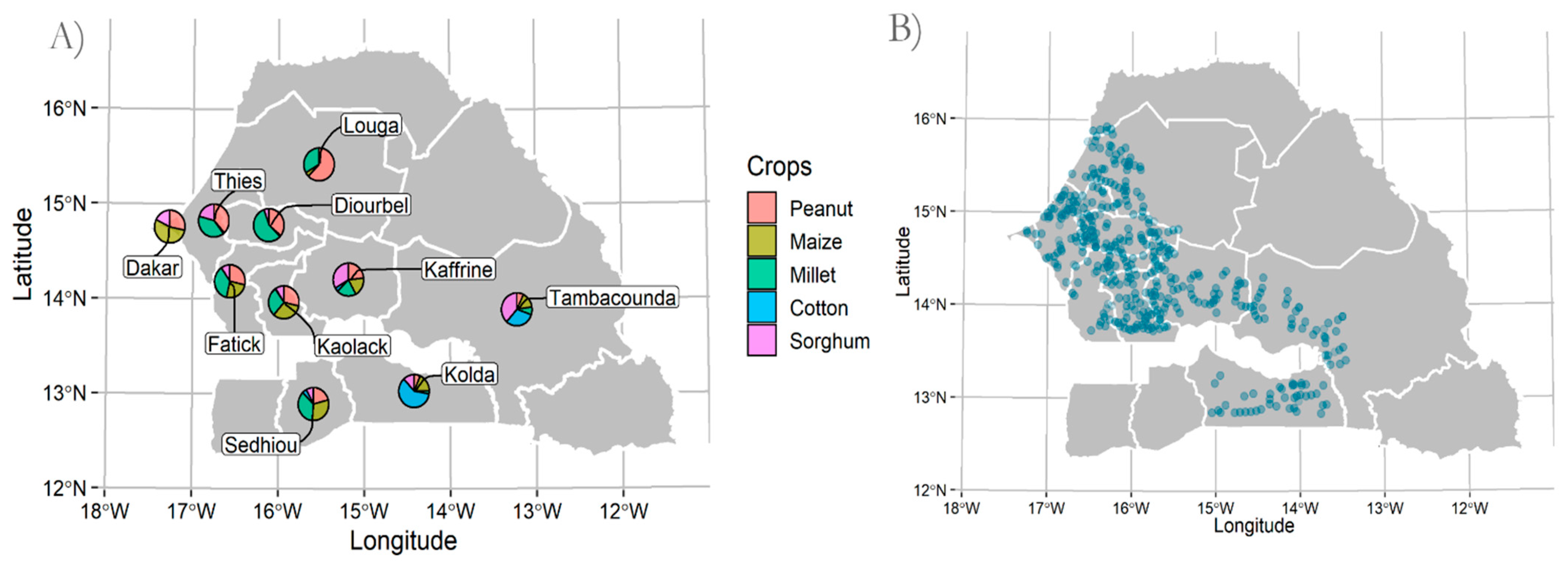
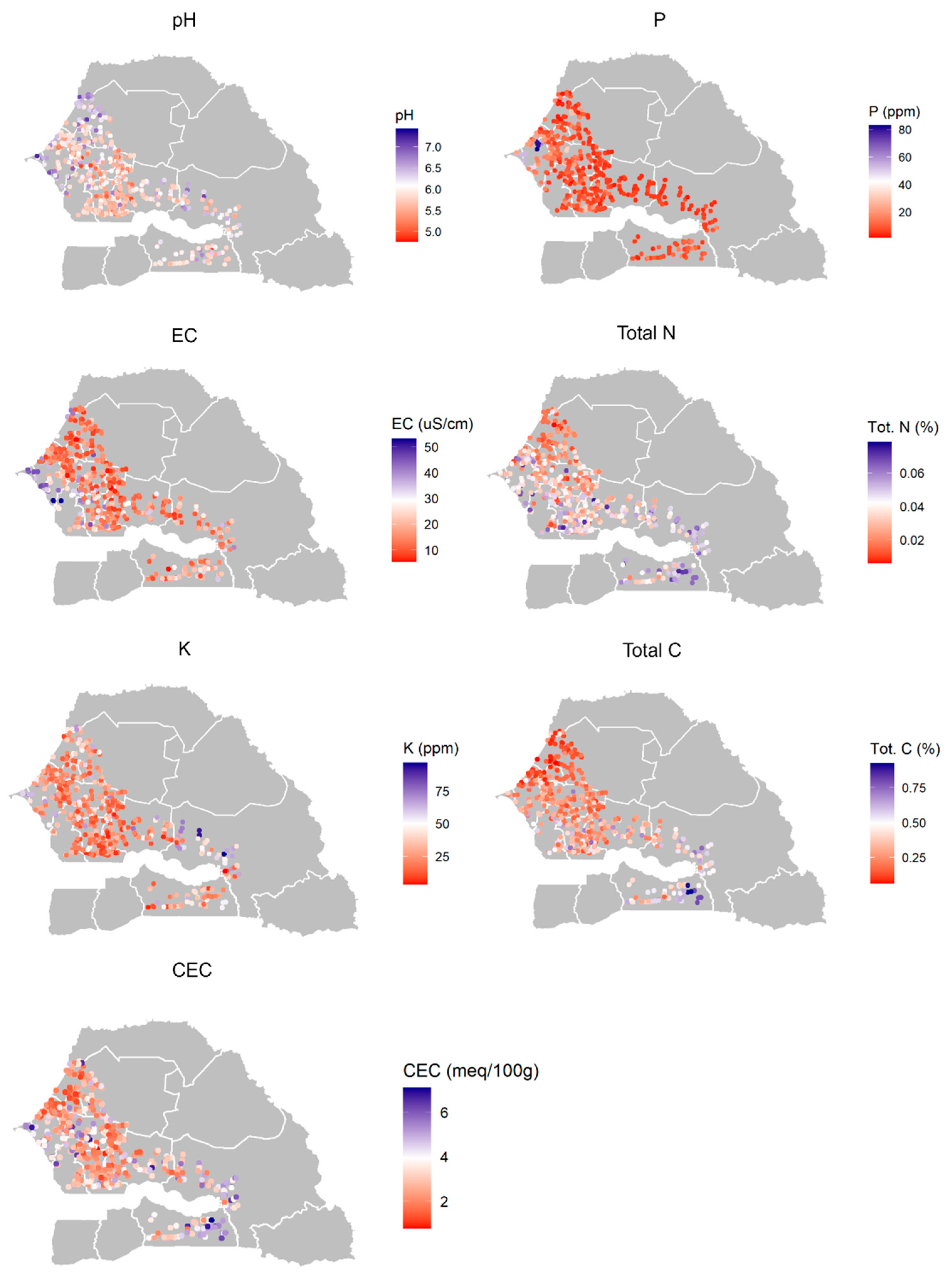
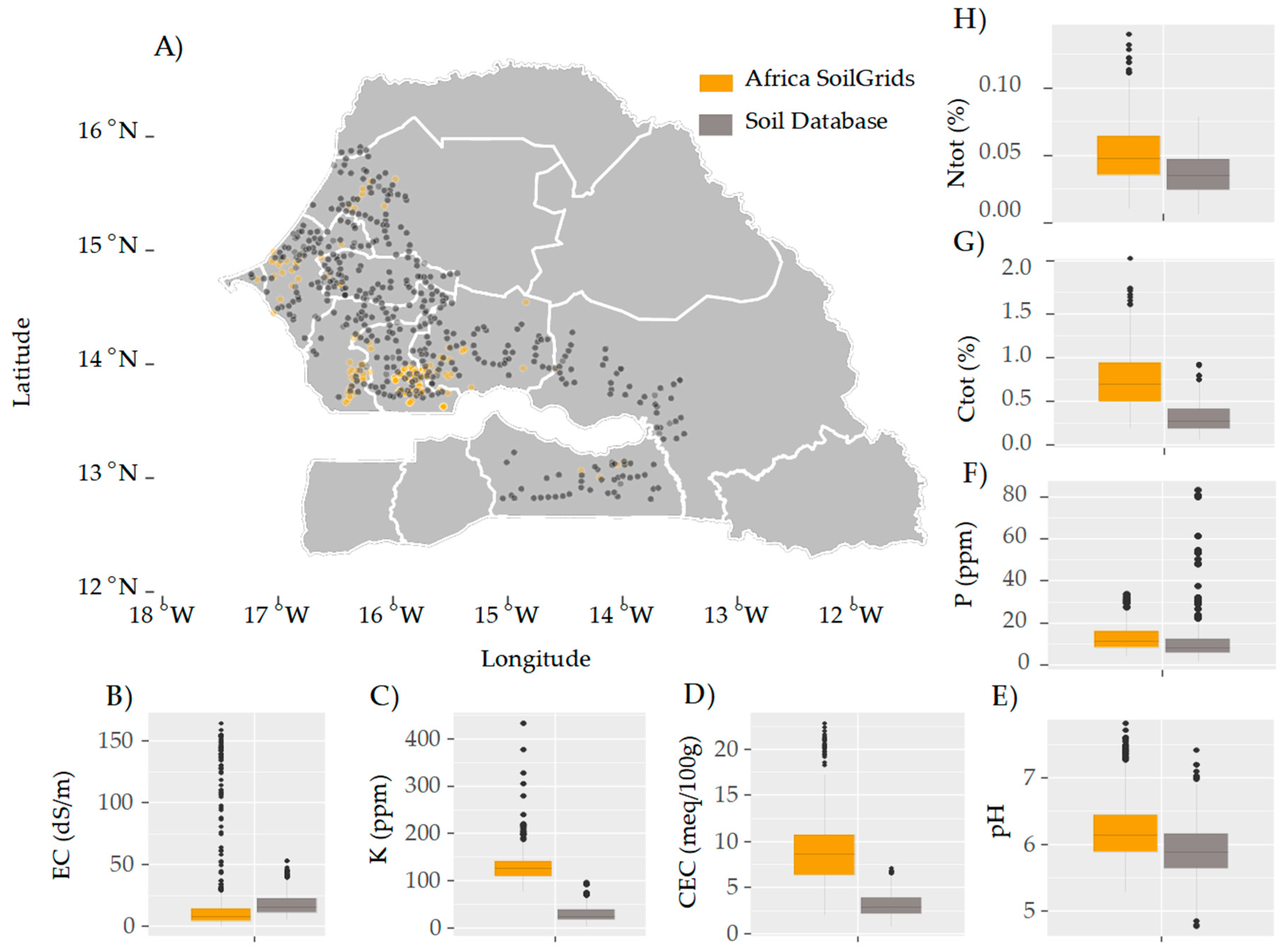
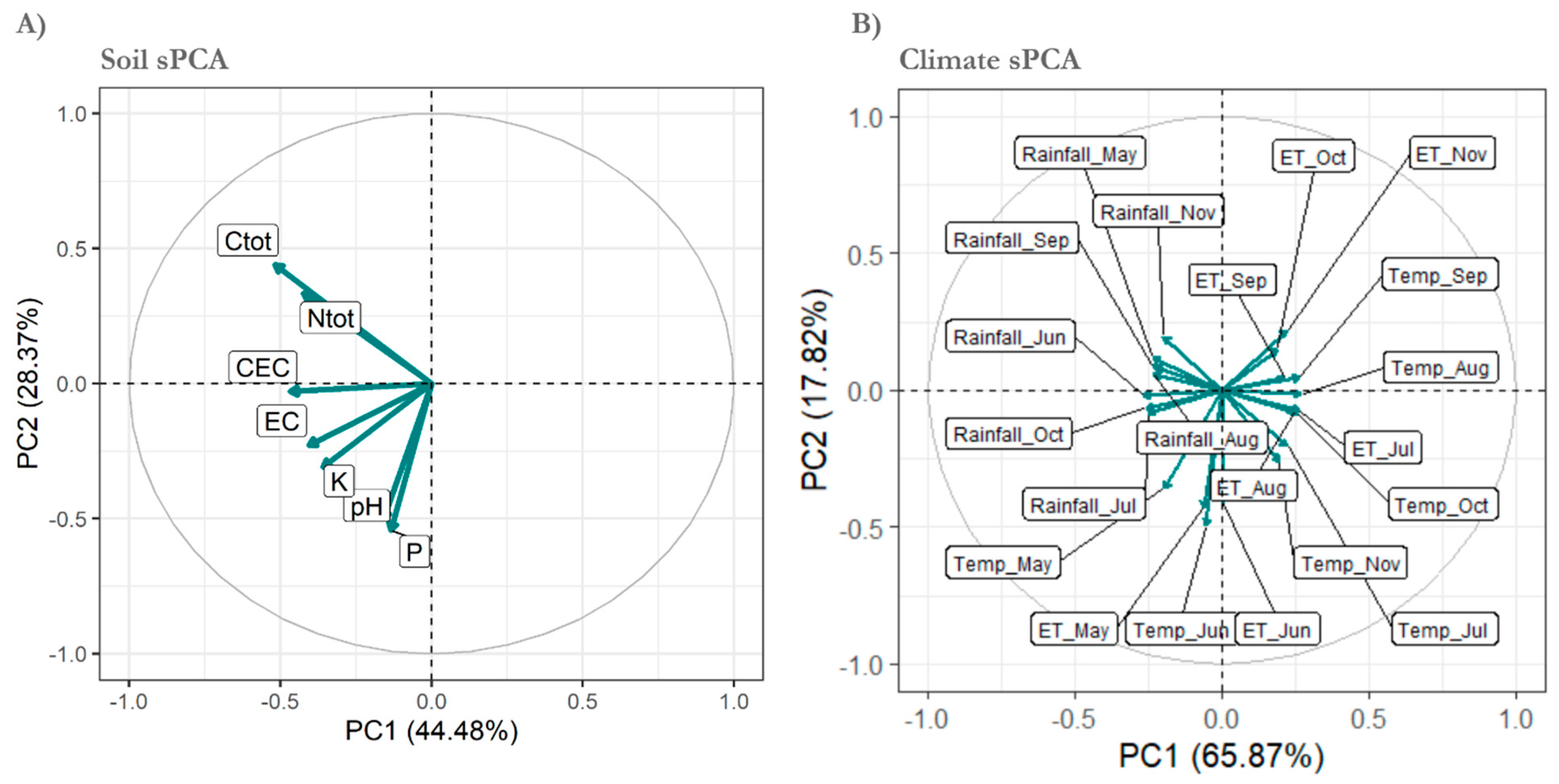
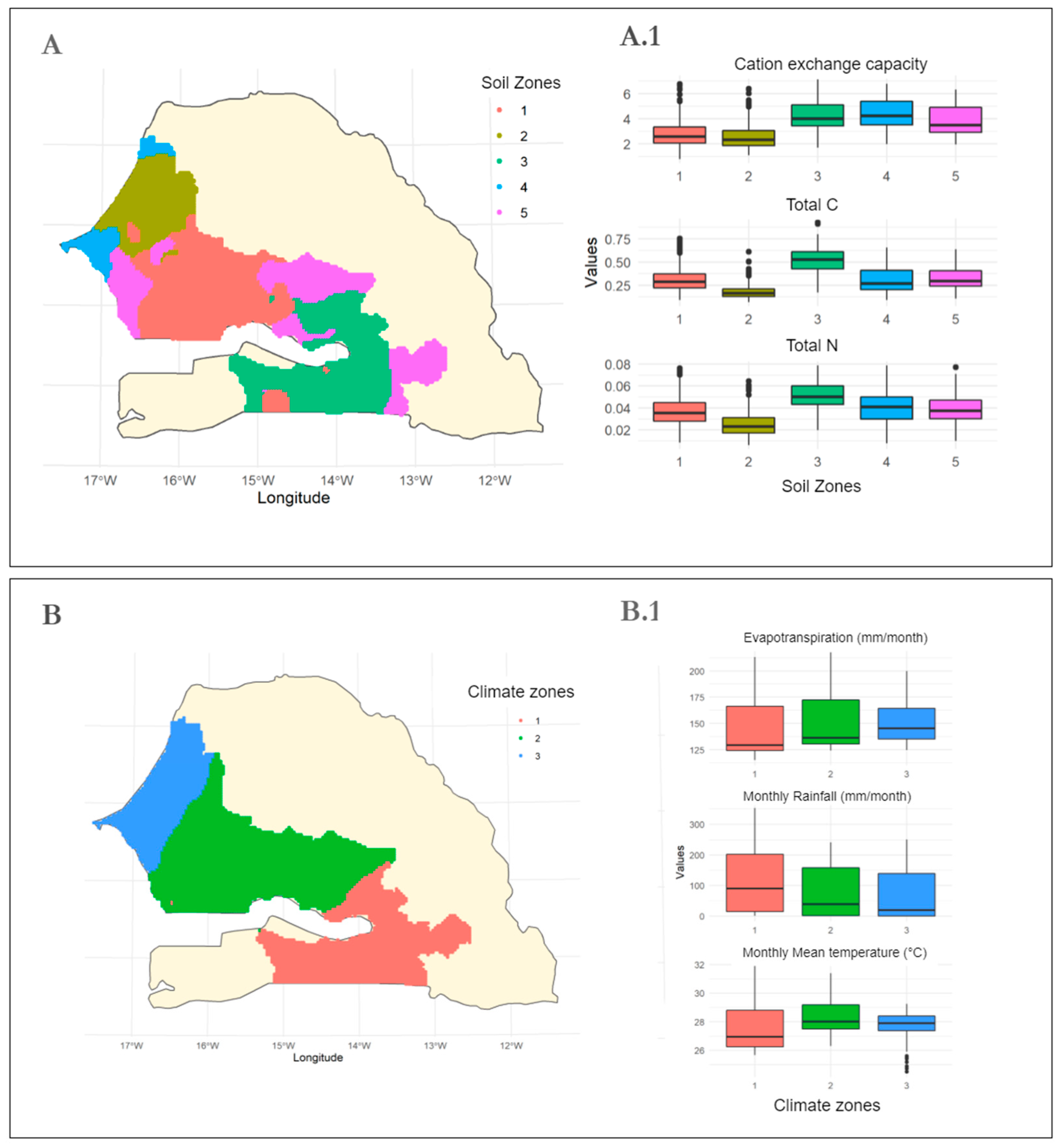
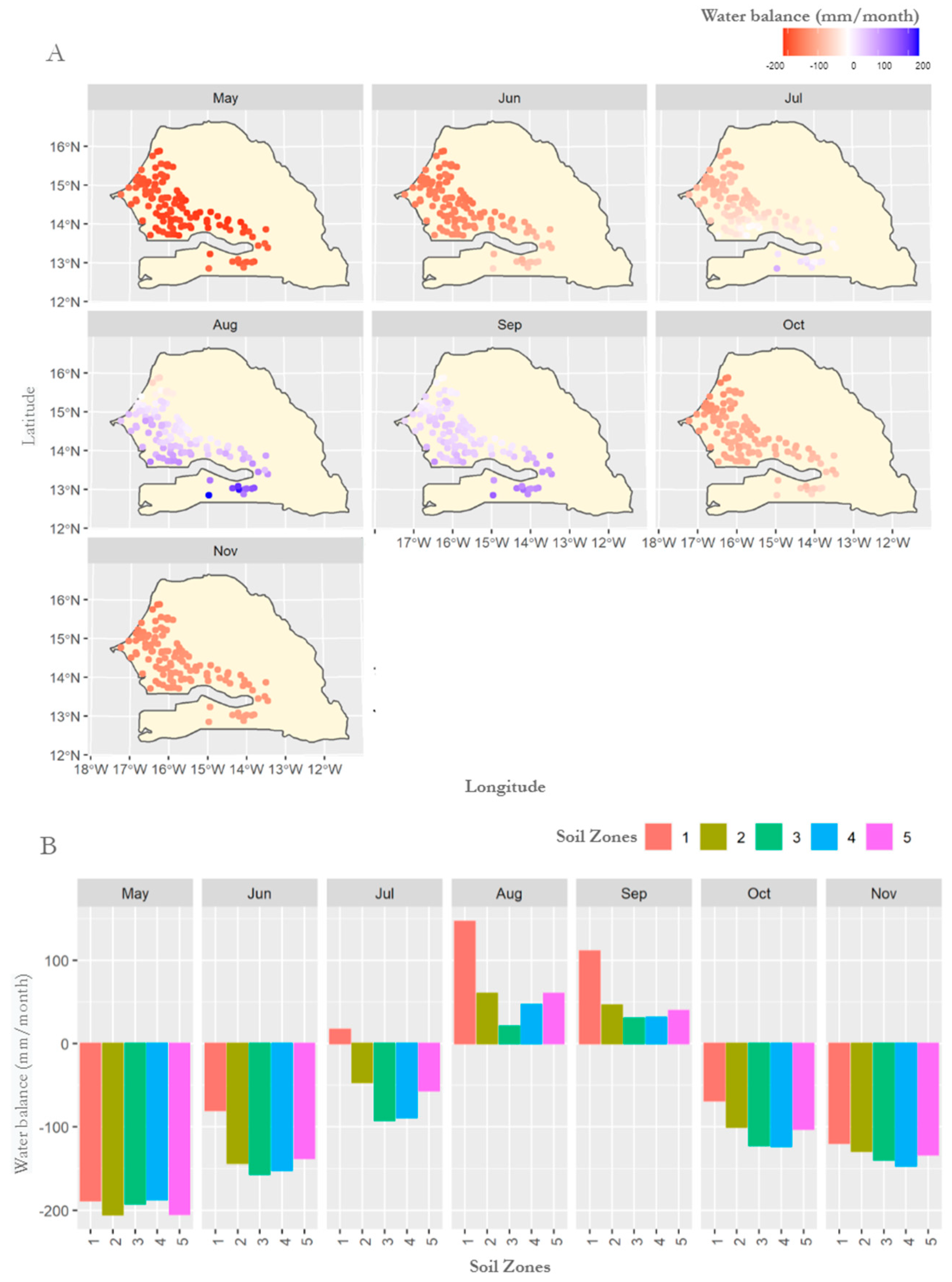
| Summer Crop | Planting Date | Harvesting Date | Planting Area (ha) | Productivity (Mg ha−1) | Total Production (Mg) |
|---|---|---|---|---|---|
| Peanut | Feb–Apr/May–Jul | Jun–Jul/Sep–Nov | 1,225,000 | 1.47 | 1,797,000 |
| Maize | Jun–Jul | Sep–Nov | 260,000 | 1.35 | 350,000 |
| Millet | Jun–Jul | Sep–Nov | 880,000 | 1.02 | 900,000 |
| Cotton | Jun–Jul | Dec | 18,000 | 0.46 | 17,230 |
| Sorghum | Jun–Jul | Sep–Nov | 240,000 | 1.15 | 275,000 |
| Product | Variable | Temporal Resolution | Spatial Resolution | Source |
|---|---|---|---|---|
| CHIRPS | Precipitation | Daily | 0.05° | http://www.chc.ucsb.edu/data/chirps—via, Google Earth Engine, accessed on 14 September 2021 |
| TERRACLIMATE | Monthly potential evapotranspiration | Average monthly cumulative | 1/24° | http://www.climatologylab.org/terraclimate.html—via, Google Earth Engine, accessed on 14 September 2021 |
| WorldClim 2.1 | Monthly Temperature | Average monthly cumulative | 2.5° | https://www.worldclim.org/data/index.html, accessed on 14 September 2021 |
| Variables | Units | Mean | Min | Max | CV (%) | MI |
|---|---|---|---|---|---|---|
| pH | 1:2 (s:w) | 5.9 | 4.7 | 7.4 | 7.2 | 0.32 |
| Electrical conductivity (EC) | uS/cm | 18.4 | 5.5 | 53 | 53 | 0.34 |
| P | ppm | 11.0 | 1.8 | 83 | 94 | 0.54 |
| K | ppm | 31 | 3.8 | 97 | 56 | 0.39 |
| Cation exchange capacity (CEC) | meq/100 g | 3.1 | 0.7 | 7.1 | 41 | 0.34 |
| Total carbon (Ctot) | % | 0.30 | 0.07 | 0.90 | 52 | 0.51 |
| Total nitrogen (Ntot) | % | 0.04 | 0.01 | 0.08 | 50 | 0.36 |
| Variable | Unit | Mean | Min | Max | CV (%) | SD |
|---|---|---|---|---|---|---|
| Average Monthly temperature | °C | 28.0 | 24.7 | 31.9 | 4.3 | 1.20 |
| Monthly Cumulative precipitation | mm/month | 78 | 0 | 338 | 24 | 81 |
| Monthly Cumulative ETo | mm/month | 150 | 115 | 217 | 11 | 26 |
Publisher’s Note: MDPI stays neutral with regard to jurisdictional claims in published maps and institutional affiliations. |
© 2021 by the authors. Licensee MDPI, Basel, Switzerland. This article is an open access article distributed under the terms and conditions of the Creative Commons Attribution (CC BY) license (https://creativecommons.org/licenses/by/4.0/).
Share and Cite
Hernández, C.M.; Faye, A.; Ly, M.O.; Stewart, Z.P.; Vara Prasad, P.V.; Bastos, L.M.; Nieto, L.; Carcedo, A.J.P.; Ciampitti, I.A. Soil and Climate Characterization to Define Environments for Summer Crops in Senegal. Sustainability 2021, 13, 11739. https://doi.org/10.3390/su132111739
Hernández CM, Faye A, Ly MO, Stewart ZP, Vara Prasad PV, Bastos LM, Nieto L, Carcedo AJP, Ciampitti IA. Soil and Climate Characterization to Define Environments for Summer Crops in Senegal. Sustainability. 2021; 13(21):11739. https://doi.org/10.3390/su132111739
Chicago/Turabian StyleHernández, Carlos Manuel, Aliou Faye, Mamadou Ousseynou Ly, Zachary P. Stewart, P. V. Vara Prasad, Leonardo Mendes Bastos, Luciana Nieto, Ana J. P. Carcedo, and Ignacio Antonio Ciampitti. 2021. "Soil and Climate Characterization to Define Environments for Summer Crops in Senegal" Sustainability 13, no. 21: 11739. https://doi.org/10.3390/su132111739
APA StyleHernández, C. M., Faye, A., Ly, M. O., Stewart, Z. P., Vara Prasad, P. V., Bastos, L. M., Nieto, L., Carcedo, A. J. P., & Ciampitti, I. A. (2021). Soil and Climate Characterization to Define Environments for Summer Crops in Senegal. Sustainability, 13(21), 11739. https://doi.org/10.3390/su132111739










